Dr. Paul Wolff and his Experiences with Leica

Dr. Paul Wolff - Imperial Highway, 1936
(Modernism in Central Europe - Exhibition at the Washington National Gallery)
If you try a search on Google for works by Paul Wolff, what you'll find is that actually there have been two Paul Wolff, both living in the same time.
There was a Paul Heinrich Oskar Wolff who lived in Dresden between 1876 and 1947. Here is one of his photographs:

The second Paul Wolff was the famous one. He lived between 1887 and 1951, and is referred usually as Dr. Paul Wolff, as he had studied medicine (though he did not practice it; he devoted himself totally to the photographic art).
Paul Wolff remained in the history of the photographic art for his lifelong relationship with the Leica camera. His life was a continue adventure to get perfection from his Leica.
He published in 1933 Meine Erfahrungen mit der Leica. Here is the book cover, followed by a photo from 1931, Die Lupe: Wolff had the same fascination for the image in whole and in detail as Vertov and Welles with their movie cameras, the same holistic approach. The same ambivalent relationship with the camera: Dziga Vertov was the Man with a Movie Camera, Wolff was the Man with a Leica; Vertov was the Kino-Glaz; Paul Wolff was the Leica-Eye.
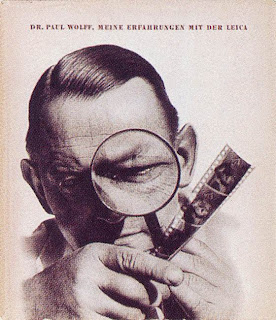
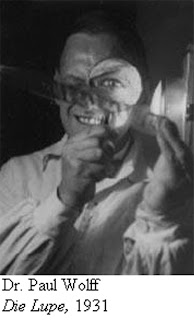

Frau mit Brille is the title of this photo, made in 1933, and the next one shows the RCA Building from New York: it was made probably in 1940.

The following photo is named Film Foto and is made in 1933. It is of a crazy beauty:

Two photos from his American trips - each one perfectly balanced: Back in the USA and Omnibus in New York:
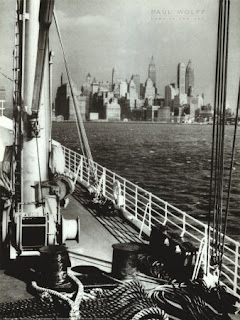

The years between the two world wars viewed the triumph of the mechanical industry and all artists were looking for the relation between art and machine. Here are three photos that show what Paul Wolff achieved in the search of the machine aesthetic: Flugzeug an Bord des Dampfers Bremen vor dem Start nach New York was made sometime between 1929 and 1931, Motorengondel Luftschiff Hindenburg was made in 1937, Flug der Hindenburg nach Rio was made in 1936:

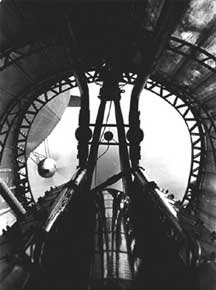

Well, the epoch was not only one of enthusiasm for machinery - the years between the two world wars claimed from the artists total political engagement. Almost all the artists of the avant-garde started their carriers with great Utopian dreams - what followed for all of them was a brutal awakening in Stalinism, Nazism, Fascism. The dictatorships rejected some of the artists, forced the others to follow the strict rules set for them.
There were some artists who took advantage of the new regimes. Paul Wolff, Max Burchartz, Leni Riefenstahl put their talents in the service of the Nazi Party. Later Leni Riefenstahl would say that she had now known the atrocities, that she was only following her artistic endeavors. There are many factors that should be considered to make a balanced judgment about their attitude in those years. We can say at least that ambition (in the negative sense of the term) played an important role for them.
If you look at the photo from the top, the Imperial Highway, it celebrates the successes of the Third Reich - only the splendid German highways were built using forced labor provided by concentration camps. So the photo actually accuses Wolff, at least of lack of decency.
The Brandenburger Tor was shot in 1936. The photo of Hitler was made in the same year. It made the cover of Time. Paul Wolff had his own photographic agency which prospered during the years of the Third Reich.


Paul Wolff was one of the photographers who covered the Berlin Olympics in 1936. He wrote a book about, Was ich bei den olympischen Spielen 1936 sah.
Here is a fine document that gathers Paul Wolff (the author of the photo), Leni Riefenstahl (who appears near a cameraman from her cruise), and the Berlin Olympics - as Leni was just leading the recording of the Games.

Paul Wolff covered the Olympics together with Alfred Tritschler. Here are some more photos made by Wolff and Tritschler: the first one (Nordseewerke - Niedersachsens einzige Großwerft) was made in 1935. The other three show the old Breslau.


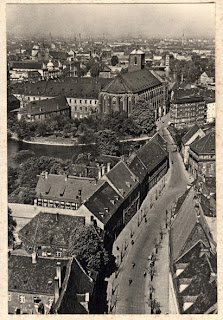
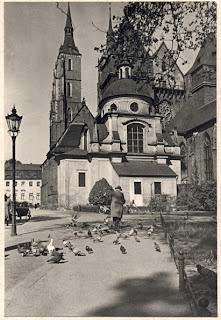
As a promoter of color photography, Wolff was enlisted for an ambitious program to record wall paintings in color during the Second World War. In 1944 his premises and archives were bombed, a loss from which he never recovered (Photography Encyclopedia, Oxford University Press).
(Modernism in Central Europe)

4 Comments:
Dr Paul Wolff was my paternal grandfather. I never knew him as I was born after he died. My father Klaus Heinrich Wolff was his firstborn son, born in 1916, but I believe he may have married again and had another son I am very curious about this and wonder if anyone can suggest ways to research this further.
By Ashley Wolff, at 2:31 AM
Ashley Wolff, at 2:31 AM
The German Autobahnen were not built with concentration labour, but by the Todt Organisation (managed by Fritz Todt) created when the Nazis came to power to overcome the high unemployment of Germans at the time. Concentration Camp slave labour was started until 1942.
By Justin Scott, at 11:20 PM
Justin Scott, at 11:20 PM
to whom it may cocern,
My name is paul Wolff Jr., and my father, Paul Wolff was born over in Louisiana on 11-10-1944. After his grandfather moved over here to Texas, from Germany. And my grandparents Otho Driscall and Susan Leonora (Norvill) Wolff were here in Texas before they traveled eastward into Louisiana where Dad(Paul Wolff) 11-10-1944_12-10-2004 was born, but they moved back to Texas when Dad was young. And then after Mom(Maxine Rose Wood) and Dad were married, my older sister Suzanne Collet Wolff(2-1-1967) and I(Wolff,pauljr.)(10-27-1968) were born.
By Anonymous, at 12:09 AM
Anonymous, at 12:09 AM
Dr Paul Wolff was my grandfather but I never knew him. My father was born in 1943, so we might somehow be related.
By Tia, at 9:38 PM
Tia, at 9:38 PM
Post a Comment
<< Home